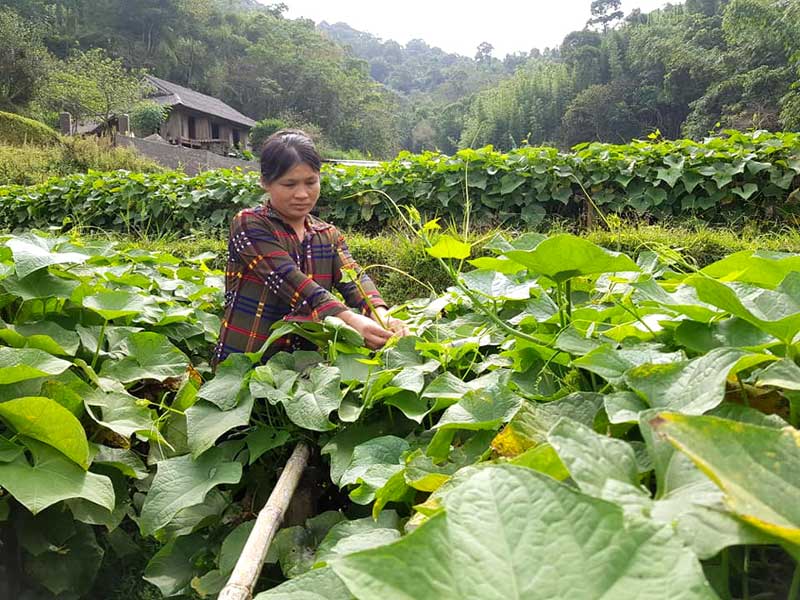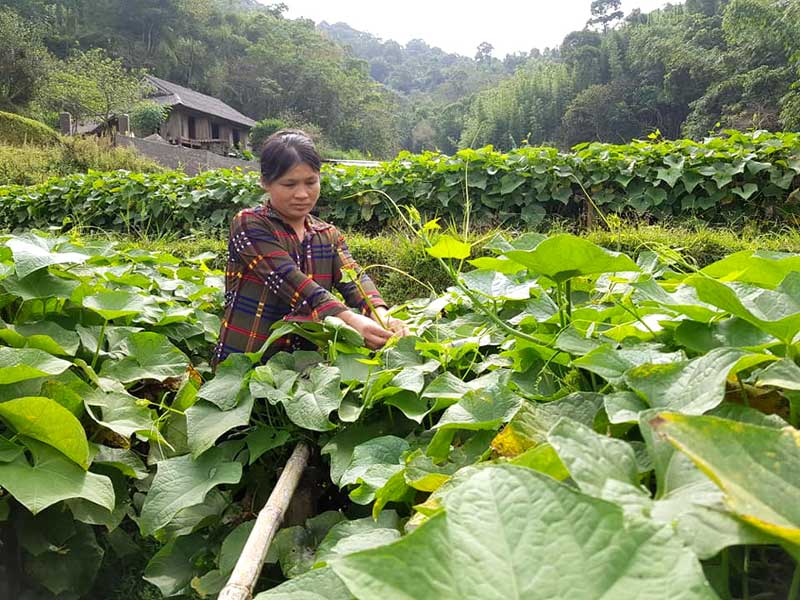
(HBO) We met Ms. Bui Thi Tuy, Lu Village, Lung Van Commune (Tan Lac) on the fair. She was always busy with the work and really impressed by the enthusiasm, diligence and thoughtfulness of the highland women who tried to escape the poverty to stabilize family life from planting chayote trees.
Today, at the fair the commune organizes a
job transaction floor, so the customers order a lot. From the early morning,
her whole family focused on cutting off the tops of the chayote trees. A lot
more other customers wanted to buy tops
of the chayote trees but there were not any left. Therefore she had to collect
tops of the chayote trees from a few families. Although customers ordered a lot,
she still carefully cut each of the green tops of vegetables, which is good for
customers. Ms. Tuy said: The entire area of the chayote trees has never been
sold in the retail market. For many years, customers have come to the gảden to buy them.

Ms. Bui Thi Tuy, Luc Village, Lung Van
Commune (Tan Lac) is harvesting the tops
of the chayote trees
Ms Tuy said: "Four years ago, my family
belonged to one of the poor households. The economy depended on growing rice,
corn and raising a few chicken. Since the commune changed the structure of
crops from poor tree planting into growing chayote trees.”Ms. Tuyet said that
the natural chayote trees adapted to the soil and climate and
they have been growing well without any care for many years. Thanks to the
broadcast media, fresh chayote vegetable in Tan Lac highland has been popular
in many places, so it is easy to sell. Cultivating chayote trees is not so
dificult with low investment capital and without much care. The trees don’t
have many pests, either. Especially, the chayote trees for tops only provides
daily harvesting and the harvest time lasts from 4 to 5 years to be replanted,
bringing the economic efficiency, which is many times higher than the other
crops. Realizing the high economic benefit, her family has focused on making
use of the available land areas to plant chayote trees. From earning a few
million dóng a month, and now her family earns an average of 10 million VND/
month from selling tops of the chayote trees.
After escaping poverty from growing chayote
trees, Ms. Tuy's family has accumulated some capital to invest in raising pigs
and chicken in the direction of goods. Each year, her family earns about 200
million VND.
According to data from the Hoa Binh Provincial Party Committee, the industrial production index for the first six months of 2025 is estimated to have increased by 20% compared to the same period last year. This marks the highest year-on-year growth rate for this period since 2020.
In the first six months of 2025, Hoa Binh province’s export turnover was estimated at 1.145 billion USD, marking an 18.11% increase compared to the same period in 2024. Import turnover was estimated at $ 804 million, a 17.15% increase, which helped the province maintain a positive trade balance.
The lives of the ethnic minority farmers in Tan Lac district have gradually improved thanks to the new directions in agricultural production. This is a testament to the collective strength fostered through the professional associations and groups implemented by various levels of the district’s Farmers’ Union.
With the motto the "product quality comes first,” after nearly one year of establishment and operation, Muong village’s Clean Food Agricultural and Commercial Cooperative, located in Cau Hamlet, Hung Son Commune (Kim Boi district), has launched reputable, high-quality agricultural products to the market that are well-received by consumers. The products such as Muong village’s pork sausage, salt-cured chicken, and salt-cured pork hocks have gradually carved out a place in the market and they are on the path to obtaining the OCOP certification.
In the past, the phrase "bumper harvest, rock-bottom prices" was a familiar refrain for Vietnamese farmers engaged in fragmented, small-scale agriculture. But today, a new spirit is emerging across rural areas of Hoa Binh province - one of collaboration, organisation, and collective economic models that provide a stable foundation for production.
Maintaining growing area codes and packing facility codes in accordance with regulations is a mandatory requirement for agricultural products to be eligible for export. Recently, the Department of Agriculture and Environment of Hoa Binh province has intensified technical supervision of designated farming areas and packing facilities to safeguard the "green passport" that enables its products to access international markets.



